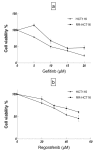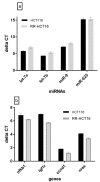Cross-Resistance of Acquired Radioresistant Colorectal Cancer Cell Line to gefitinib and regorafenib
- PMID: 32038059
- PMCID: PMC6983275
- DOI: 10.30476/ijms.2019.44972
Cross-Resistance of Acquired Radioresistant Colorectal Cancer Cell Line to gefitinib and regorafenib
Abstract
Background: Usually, chemoradiotherapy can be used for the treatment of locally advanced colorectal cancer (CRC) before surgery. On the other hand, some studies have shown that fractional radiation of tumor cells leads to chemoresistance. The aim of this study was to evaluate the chemoresistance of radioresistant sub-line (RR sub-line).
Methods: This study was done in Hamadan University of Medical Sciences in 2017-2018. MTT assay and sub-G1 fraction analysis by flow cytometry were used to evaluate cross-resistance of RR sub-line to gefitinib and regorafenib. Real-time PCR was used to investigate the role of four miRNAs and their target genes in the cross-resistance of RR sub-line. The t test and repeated measures test were used for the assessment of statistical significance between groups.
Results: The IC50 of gefitinib and regorafenib for RR sub-line were significantly higher than those of the parental cell line. On the other hand, the resistance index of RR sub-line for gefitinib and regorafenib were 1.92 and 1.44, respectively. The sub-G1 fraction of RR sub-line following treatment with gefitinib and regorafenib was significantly lower than that of the parental cell line (P=0.012 and P=0.038, respectively). The expression of miR-9, Let-7e, and Let-7b in RRsub-line was significantly lower than that of the parental cell line. However, NRAS, IGF1R, NFKB1, and CCND1 found to be upregulated in RR sub-line in comparison with the parental cell line.
Conclusion: We can conclude that the acquired RR sub-line was cross-resistance to gefitinib and regorafenib. Furthermore, miR-9/NFKB1, let-7b/CCND1, let-7e/NRAS, and IGF1R played essential roles in the chemoradioresistance of CRC.
Keywords: Colorectal neoplasms; Drug resistance; MicroRNAs; gefitinib; regorafenib.
Copyright: © Shiraz University of Medical Sciences.
Figures



References
-
- Geng L, Wang J. Molecular effectors of radiation resistance in colorectal cancer. Precis Radiat Oncol. 2017;1:27–33. doi: 10.1002/pro6.5. - DOI
-
- Bronte G, Rolfo C, Giovannetti E, Cicero G, Pauwels P, Passiglia F, et al. Are erlotinib and gefitinib interchangeable, opposite or complementary for non-small cell lung cancer treatment? Biological, pharmacological and clinical aspects. Crit Rev Oncol Hematol. 2014;89:300–13. doi: 10.1016/j.critrevonc.2013.08.003. - DOI - PubMed
-
- Carr BI, Cavallini A, Lippolis C, D’Alessandro R, Messa C, Refolo MG, et al. Fluoro-Sorafenib (regorafenib) effects on hepatoma cells: growth inhibition, quiescence, and recovery. J Cell Physiol. 2013;228:292–7. doi: 10.1002/jcp.24148. [ PMC Free Article ] - DOI - PMC - PubMed
-
- Yar Saglam AS, Alp E, Elmazoglu Z, Menevse S. Treatment with cucurbitacin B alone and in combination with gefitinib induces cell cycle inhibition and apoptosis via EGFR and JAK/STAT pathway in human colorectal cancer cell lines. Hum Exp Toxicol. 2016;35:526–43. doi: 10.1177/0960327115595686. - DOI - PubMed
LinkOut - more resources
Full Text Sources
Research Materials
Miscellaneous
